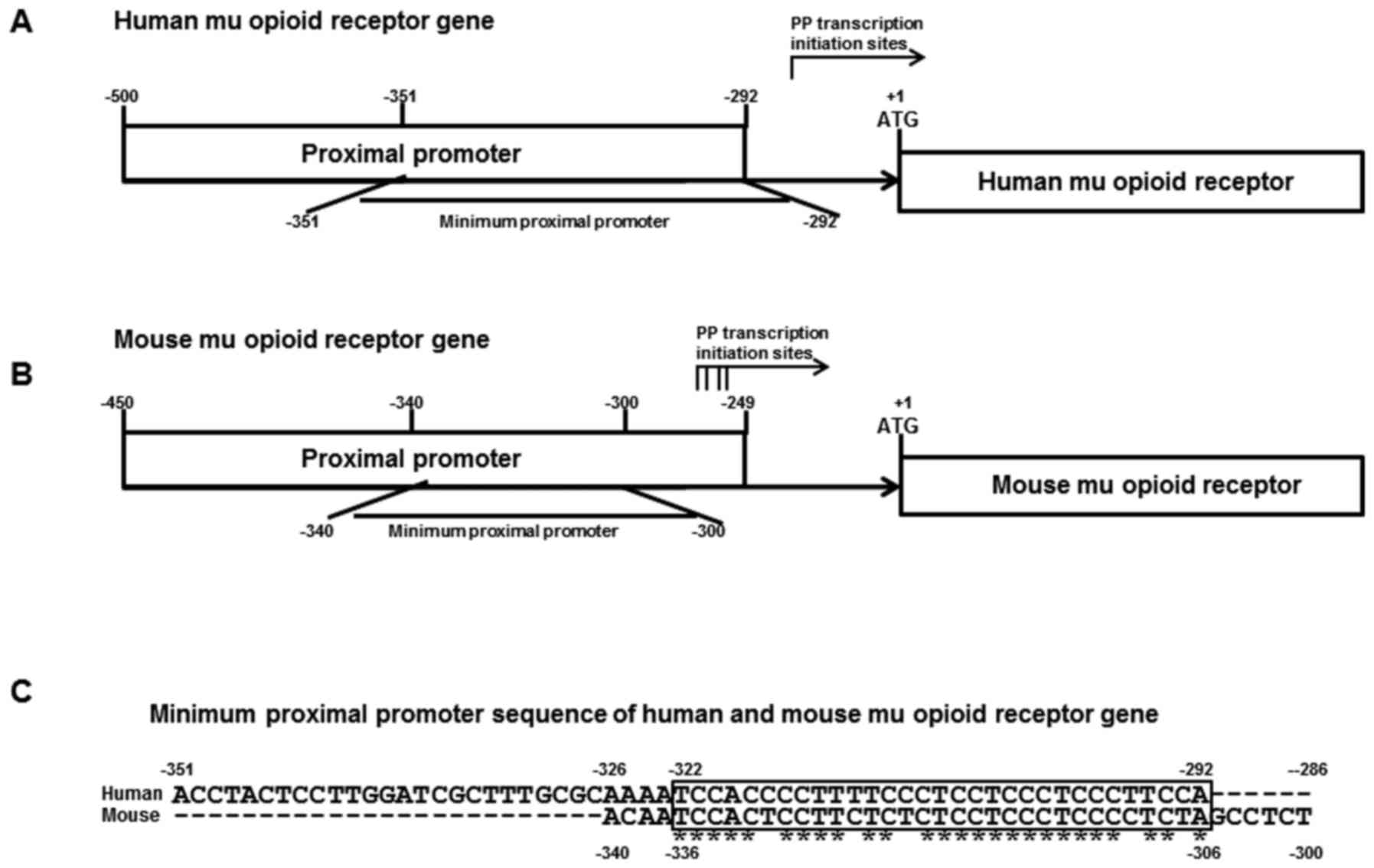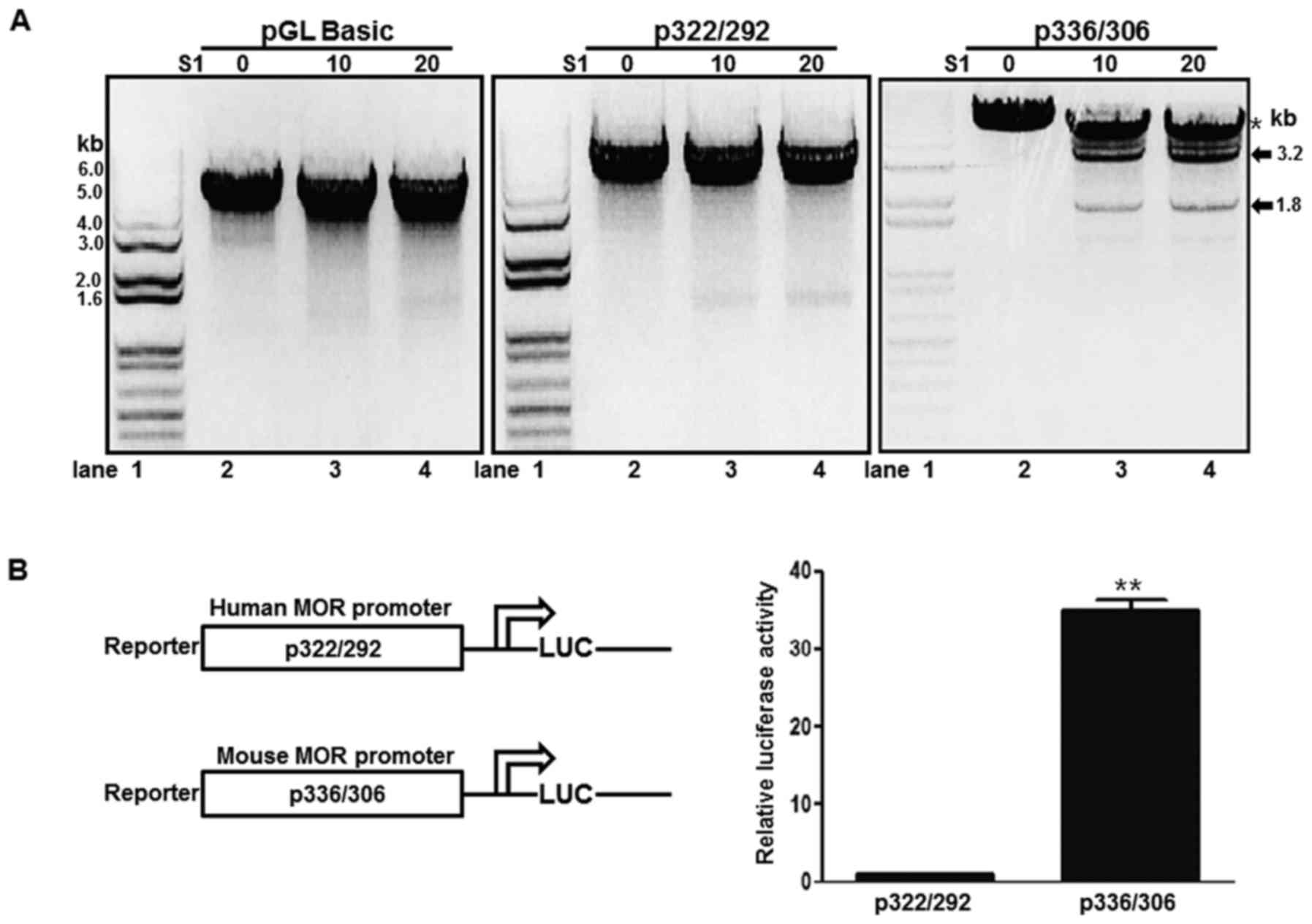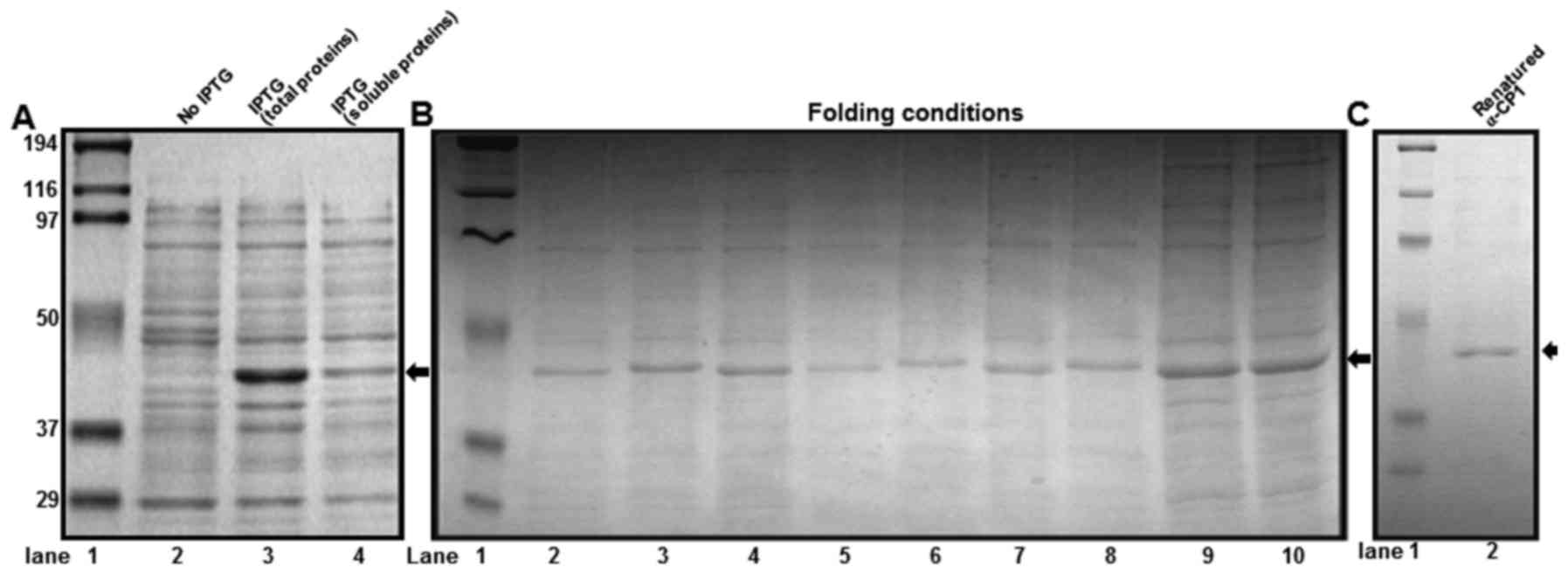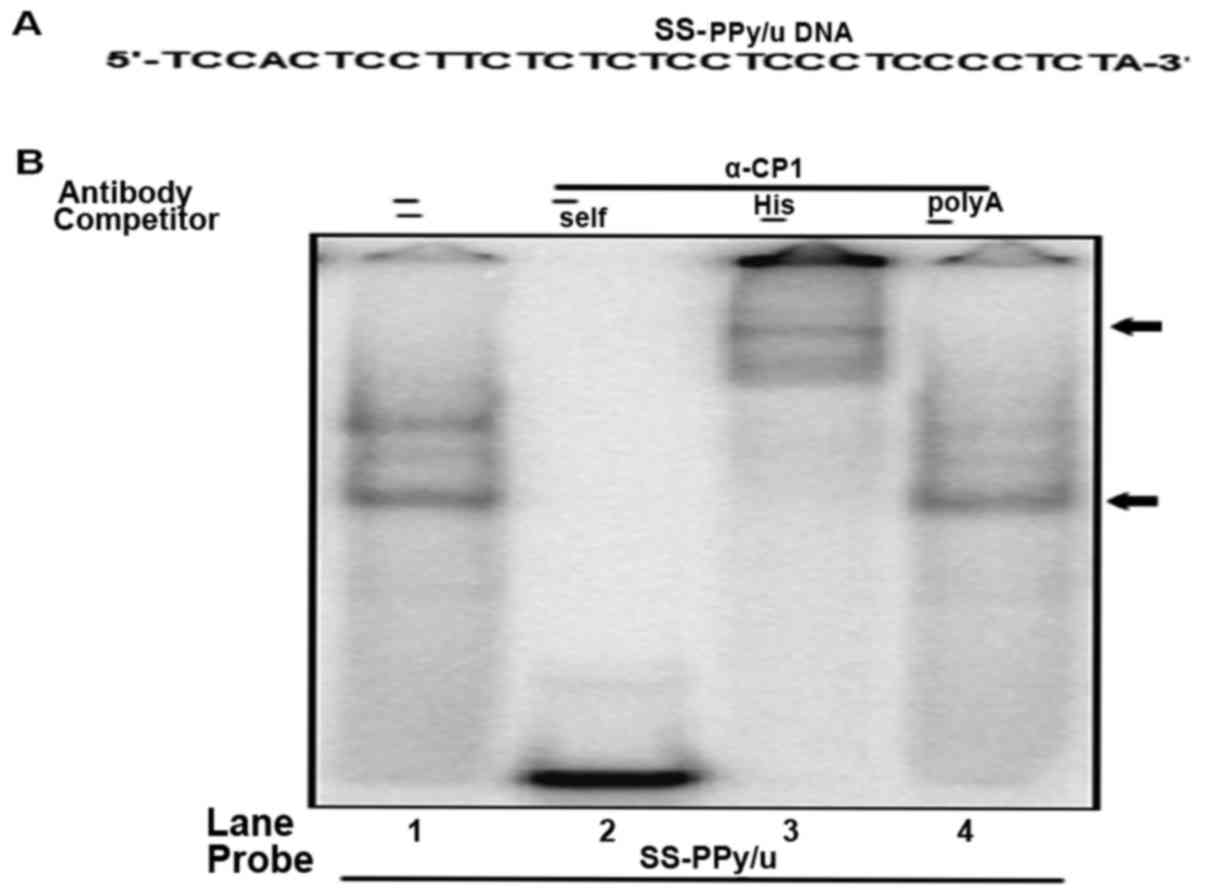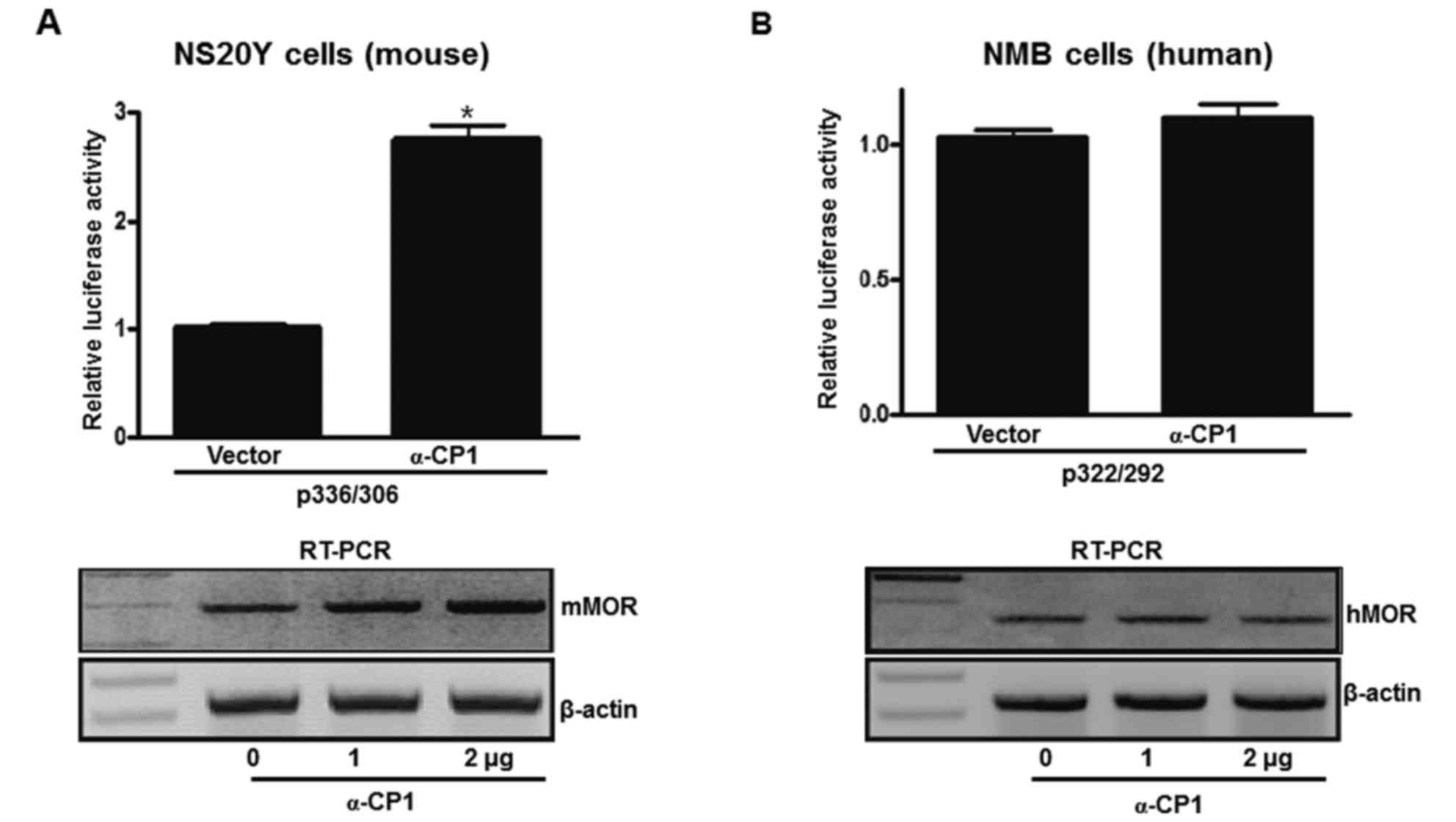Differential regulation of mouse and human Mu opioid receptor gene depends on the single stranded DNA structure of its promoter and α-complex protein 1
- Authors:
- Published online on: March 21, 2017 https://doi.org/10.3892/br.2017.877
- Pages: 532-538
Abstract
Introduction
Opioids are wildly administered for treatment and control of moderate and severe pains. Their efficiency is dependent on the ability to mimic endogenous peptides on the opioid receptors. Opioid receptors are classified into three types of receptor (µ, δ and κ) characterized by molecular cloning and these receptors have been investigated in numerous pharmacological studies (1,2). The Mu opioid receptor (MOR) is involved in morphine-induced analgesia, tolerance and dependence according to pharmacological studies and analysis of MOR knockout mice (3–5). Upon opioid binding, MOR couples with G-protein-coupled receptors, regulates adenylyl cyclase, intracellular calcium and mitogen-activated protein kinase, then triggers a cascade of intracellular events (6). MOR is a major molecular target of analgesic drugs, morphine, heroin, methadone and fentanyl (7).
MOR is predominantly expressed in the central nervous system, and differential expression of MOR is dependent on receptors of varying densities in different regions (8,9). Individual human and mouse strains differ in their responses to pain and opiate drugs (10,11). Although humans and mice exhibit a different response to opiates, to the best of our knowledge, there have been no studies on these differential responses. Only one study indicated that single nucleotide polymorphisms (SNPs) are associated with mice with differences in morphine preference (12).
Mouse MOR (mMOR) gene expression is regulated by distal and proximal promoters (DP and PP, respectively). The two promoters are similar to housekeeping genes that are lacking a TATA box. The distal promoter is less active, by 20-fold, than the PP in adult and embryonic mouse brains as determined using reverse transcription-polymerase chain reaction (RT-PCR) (13). The proximal core promoter of the mMOR gene contains the polypyrimidine/polypurine (PPy/u) region, and the PP of the human MOR (hMOR) gene contains a similar PPy/u region that is located nearby at transcription initiation site (14,15). The PPy/u region of the mMOR gene promoter strongly activates the MOR gene and contains a 26-bp CT-rich region with overlapping single- and double-stranded DNA sequences, and multiple binding sites for Sp1, Sp3 and single-stranded binding proteins (16,17). Regulation of hMOR gene expression in neuronal cells is not well understood compared with mMOR gene regulation. The hMOR promoter contains a deferoxamine-response CT-rich region that is located close to the translational initiation site (18). PPy/u motifs are the common sequence in eukaryotic cells (19) and possess special chemical properties, including a non-B DNA conformation sensitive to S1 nuclease, a triple-stranded forming DNA structure and guanine-rich guanosine, and a G-quartet structure that is often observed at the centromere and telomere (19).
In the current study, the structural conformation of the PPy/u motif and poly(C) binding protein (PCBP1), α-complex protein 1 (α-CP1) were demonstrated to regulate different transcriptional activation via the PPy/u motifs on human and mouse MOR genes. To the best of our knowledge, this is the first comparative investigation of the mouse and human MOR gene expression that focuses on the key transcriptional regulatory element sequence PPy/u motif and the α-CP1 protein. Furthermore, the reasons for and theoretical backgrounds regarding why humans and mice exhibit different responses to pain and opiate drugs are explained.
Materials and methods
Plasmid construction
The mouse promoter construct p336/306 was generated by ligating an annealed double-stranded oligonucleotide into the SacI and HindIII sites of a pGL3-basic vector (Promega Corporation, Madison, WI, USA) using the following oligonucleotide sequences: Sense, 5′-ATTGAGCTCTCCACTCCTTCTCTCTCCTCCCTCCCCTCTAAAGCTTTTC-3′) containing a SacI and HindIII site (underlined) and antisense, 5′-GAAAAGCTTTAGAGGGGAGGGAGGAGAGAGAAGGAGTGGAGAGCTCAAT-3′ containing a HindIII and SacI site (underlined). The human promoter construct p322/292 was generated by ligating an annealed double-stranded oligonucleotide into the SacI and HindIII sites of pGL3-basic vector using the following oligonucleotide sequences: Sense, 5′-ATTGAGCTCTCCACCCCTTTTCCCTCCTCCCTCCCTTCCAAAGCTTTTC-3′ containing a SacI and HindIII site (underlined) and antisense, GAAAAGCTTTGGAAGGGAGGGAGGAGGGAAAAGGGGTGGAGAGCTCAAT-3′ containing a HindIII and SacI site (underlined). To clone the α-CP1 gene, total RNA was isolated from mouse NS20Y cells obtained from the American Type Culture Collection (ATCC; Manassas, VA, USA). RNA was treated with RNase-free DNase (Promega Corporation) according to the manufacturer's instructions. RT-PCR was performed using the OneStep RT-PCR kit (Qiagen, Inc., Valencia, CA, USA). PCR was performed with primers that were designed using the gene sequence information for each protein: α-CP1 (Gene ID, 13435897): Sense primer, 5′-CCATGGACGCCGGTGTGACTGA-3′ and antisense primer, 5′-GCTGCACCCCATCCCCTTCTC-3′. The PCR conditions were as follows: 94°C for 3 min; 35 cycles of 94°C for 1 min, 55°C for 1 min, and 72°C for 1 min; and 72°C for 10 min. RT-PCR products were excised from a 1% agarose gel, purified using a QIAQuick gel extraction kit (Qiagen, Inc.) and cloned into a pCRII-TOPO vector (Invitrogen; Thermo Fisher Scientific, Inc., Waltham, MA, USA). The candidate plasmids containing inserts of the correct size were confirmed using restriction enzyme digestion and DNA sequencing on an ABI 3100 sequencer (Applied Biosystems; Thermo Fisher Scientific, Inc.). For the transient expression studies, the α-CP1 gene was cloned by digesting the above-mentioned pCRII-TOPO α-CP1 clone with 5′-HindIII and 3′-XhoI into the same sites of a pcDNA4 vector (Invitrogen; Thermo Fisher Scientific, Inc.), generating a pcDNA4-α-CP1 plasmid. DNA sequences of all constructs were confirmed using DNA sequencing. For the protein expression studies in Escherichia coli, the α-CP1 gene was cloned by digesting the above-mentioned pcDNA4-α-CP1 plasmid with 5′-HindIII and 3′-XhoI into the same sites of a pET21b vector (EMD Millipore, Billerica, MA, USA), generating a pET21b-α-CP1 plasmid. The DNA sequences of all constructs were confirmed using DNA sequencing.
α-CP1 protein expression
The α-CP1 protein expression was performed as described previously (20). The protein was expressed in a Lysogeny broth medium (Sigma-Aldrich; Merck KGaA, Darmstadt, Germany) containing ampicillin (50 µg/ml). To obtain the protein, several cell growth conditions were generated by varying the temperature (16, 30 and 37°C) and isopropyl β-D-1-thiogalactopyranoside (IPTG) concentration (0.1, 0.5 and 1 mM). Typically, 2 ml overnight culture was added to 100 ml medium and incubated with vigorous shaking at ~37°C. When the culture reached optical density (OD)600=0.5, protein expression was induced with 1 mM IPTG. Subsequent to induction, the samples were further incubated at 37°C for 4 h. The cells were harvested by centrifugation at 10,000 × g for 10 min at 4°C, washed with TE buffer (10 mM Tris-HCl and 1 mM EDTA; pH 8.0) and stored at −80°C.
Folding of the α-CP1 protein
The folding of the α-CP1 protein was performed as described previously (20). The twice water-washed inclusion bodies were resuspended in 5 volumes of Buffer C (20 mM Tris-HCl, 1 mM EDTA, 10 mM DTT and 8 M Urea; pH 7.0), stirred at room temperature for 60 min and centrifuged at 10,000 × g for 15 min at room temperature. The pellet was discarded and the supernatant (5–10 mg/ml) was collected in a fresh tube. The refolding experiments were performed using protein-folding spin-columns following the manufacturer's recommendation (ProFoldin, Hudson, MA, USA).
Preparation of inclusion bodies and purification of recombinant α-CP1 protein
The preparation of inclusion bodies and purification of recombinant of the α-CP1 protein were performed as described previously (20). The cell pellet was resuspended in 30 ml Buffer A (20 mM Tris-HCl, 100 mM NaCl and 1 mM PMSF; pH 7.0) and sonicated at 4°C with 5 cycles. The lysate was centrifuged at 10,000 × g for 15 min at 4°C. The pellet was resuspended in 5 volumes of Buffer A, stirred at room temperature for 5 min and centrifuged at 10,000 × g for 15 min at 4°C. The inclusion bodies were then washed three times with 10 volumes of 20 mM Tris-HCl containing 100 mM NaCl at pH 7.0. The inclusion body pellet was resuspended in 30 ml Buffer B [50 mM NaH2PO4, 300 mM NaCl (pH 8.0) and 8 M urea] to solubilize the inclusion bodies. Sonication was necessary to suspend the pellet. The suspension was centrifuged at 10,000 × g for 20 min and the supernatant was transferred to fresh clean tubes. The supernatant was then added to an equilibrated Ni-NTA column (Qiagen, Inc.) and allowed to drain. The column was washed with Buffer B, and the 6x His-tagged α-CP1 was eluted using an elution buffer [50 mM NaH2PO4, 300 mM NaCl, 250 mM imidazole (pH 8.0) and 8 M urea]. Anti-His antibodies were purchased from Sigma-Aldrich; Merck KGaA. To determine which fractions contain the His-tagged α-CP1, an aliquot of each sample was analyzed using 10% SDS-PAGE.
SDS-PAGE, in-gel tryptic digestion and matrix-assisted laser desorption ionization-time of flight (MALDI-TOF) mass spectrometric analysis of α-CP1
The purified α-CP1 protein was resolved on a 10% SDS-PAGE gel. The Coomassie blue-stained gel was destained, and a gel slice containing the band of interest was subjected to in-gel tryptic digestion as described previously (20,21). The tryptic peptides were extracted with 5% acetic acid, followed by 5% acetic acid and 50% acetonitrile. The samples were dissolved in 5% acetic acid and desalted using ZipTip™ C18 reverse-phase desalting Eppendorf tips (EMD Millipore). The peptides were eluted with 2% acetonitrile containing 0.1% TFA in a volume of 20 µl. The samples were analyzed using a MALDI-TOF mass spectrometer (Applied Biosystems; Thermo Fisher Scientific, Inc.). The masses of the monoisotopic peaks were compared with a theoretical digestion of the protein by trypsin. Mascot database searching software (Matrix Science; http://www.matrixscience.com) was used to identify the α-CP1 protein.
DNA electrophoretic mobility shift assay (EMSA)
The EMSA was performed as described previously (20,22). The polypyrimidine/polypurine (PPy/u) oligonucleotide, single-stranded probe (5′-TCCACTCCTTCTCTCTCCTCCCTCCCCTCTA-3′) was end-labeled with [γ-32P] dATP. The free nucleotides were separated using centrifugation at 1,100 × g for 4 min at room temperature through a Sephadex G-25 column (Roche Diagnostcs, Indianapolis, IN, USA). The end-labeled ssDNA probes were incubated with recombinant α-CP1 (0.5 µg) in a final volume of 20 µl EMSA buffer [10 mM Tris (pH 7.5), 5% glycerol, 1 mM EDTA, 50 mM NaCl, 1 mM DTT, 0.1 mg/ml poly (dI-dC)] at room temperature for 20 min. For the oligonucleotide competition analyses, a 100-fold molar excess of a cold competitor oligonucleotide was added to the mixture prior to adding the probe. The reactions were then incubated at 4°C for 30 min. The reaction mixtures were electrophoresed at 160 V for 2 h on a non-denaturing 4% polyacrylamide gel in 0.5X TBE (45 mM Tris-borate and 1 mM EDTA) at 4°C and visualized using autoradiography.
S1 nuclease sensitivity assay
The pGL-basic plasmids, p322/292 and p336/306, were digested with various quantities of the S1 nuclease (Promega Corporation) in S1 nuclease buffer for 15 min at 37°C as described previously (20). The digestion was terminated using phenol/chloroform extraction and the plasmids were recovered by precipitation. The resulting S1-treated plasmids were digested further using XbaI (Promega Corporation) and the products were resolved using electrophoresis on a 1% agarose gel at 100 V for 1 h.
Transient transfection and reporter gene assays
Mouse neuroblastoma NS20Y cells and human neuronal NMB cells obtained from the ATCC were grown in Dulbecco's modified Eagle's medium supplemented with 10% heat-inactivated fetal bovine serum (GE Healthcare Life Sciences, Chalfont, UK) at 37°C in a humidified atmosphere of 5% CO2. NS20Y cells were plated in 6-well dishes at a concentration of 0.5×106 cells/well and cultured overnight before transfection. Equimolar concentrations of various plasmids were transfected using the Effectene transfection reagent (Qiagen, Inc.) as described previously (20,23). Briefly, for the luciferase analysis of the p336/306 and p322/292 promoters, 0.5 µg of the reporter plasmids was combined with the Effectene transfection reagent for 10 min before being added to the NS20Y cells. Forty-eight h after transfection, the cells that were grown to confluence were washed once with phosphate-buffered saline and lysed with lysis buffer (Promega Corporation). To correct for differences in transfection efficiency, a one-fifth molar ratio of pCH110 (GE Healthcare Life Sciences) containing the β-galactosidase gene under the SV40 promoter was included in each transfection for normalization. The luciferase (Promega Corporation) and β-galactosidase (Promega Corporation) activities of each lysate were determined according to the manufacturer's recommendations.
RT-PCR and heterologous expression of α-CP1
Total RNA was isolated using TRI Reagent (Molecular Research Center, Inc., Cincinnati, OH, USA) according to the supplier's protocol. For RT-PCR, 2 µg total RNA and the OneStep RT-PCR reagent (Qiagen, Inc.) were used. The PCR cycle conditions consisted of 95°C for 1 min, 60°C for 1 min and 72°C for 1 min followed by a 10-min extension at 72°C. Mouse-specific primers were as follows: 5′-CATCAAAGCACTGATCACGATTCC-3′ and 5′-TAGGGCAATGGAGCAGTTTCTGC-3′ for MOR; 5′-TGGCCTTAGGGTGCAGGGGG-3′ and 5′-GTGGGCCGCTCTAGGCACCA-3′ for β-actin. The human-specific primers were as follows: 5′-CCTTCCTGGGCATGGAGTCCTG-3′ and 5′-TACAGCGAGGCCAGGATGG-3′ for β-actin; 5′-CTGGAAGGGCAGGGTACTGGTG-3′ and 5′-CTGCCCCCACGAACGCCAGCAAT-3′ for MOR.
Statistical analysis
All data were presented as the mean ± standard deviation. Data were analyzed using Student's t-test. P<0.05 was considered to indicate a statistically significant difference and GraphPad Prism 5 Software (GraphPad Software, Inc., La Jolla, CA, USA) was used to perform the analyses.
Results
Promoter structure and comparison of the minimum PP sequence of human and mouse MOR gene
Transcription of the mMOR gene starts at four sites located between −291 and −268 of the MOR gene using two promoters: The PP (−450 to −249) and the DP (−1,326 to +1; Fig. 1B). The PP was responsible for major MOR gene activity (~95%) in the mouse brain. The regulatory elements of the PP contained PPy/u and a canonical Sp1 binding site. The PPyy/u exhibited an ssDNA conformational structure (15). Transcription of the hMOR gene starts at the −256 site and the hMOR gene also uses two promoters: The PP (−500 to −292) and the DP (−2,388 to +1; Fig. 1A). The regulatory elements of the human PP contained PPy/u and a canonical Sp1/3 binding site. Structural analysis of MOR PPy/u indicated that mMOR PPy/u is highly homologous to hMOR PPy/u (84%; Fig. 1C).
Differential S1 nuclease sensitivity and promoter activity of human and mouse MOR promoters containing PPy/u motifs
ssDNA structures derived from the non-B DNA form or intracellular triple helix structures are sensitive to low concentrations of S1 nuclease (15). In order to analyze the structural differences of human and mouse MOR PPy/u motifs, an S1 nuclease treatment was performed in the current study. A p322/292 plasmid containing the human PPy/u motif was treated with S1 nuclease and digested with XbaI. In the presence of S1 nuclease, the XbaI treatment produced a 5-kb linear DNA (Fig. 2A, middle panel). In addition, the pGL-basic plasmid demonstrated a similar result (Fig. 2A, left panel). A p336/306 plasmid containing the mouse PPy/u motif was treated with S1 nuclease and digested with XbaI. Two DNA bands, 3.2 and 1.8 kb, were produced and the band density was increased with increasing quantities of S1 nuclease (Fig. 2A, right panel). These results indicate that the mouse PPy/u motif is an ssDNA structure, whereas the human motif is a double-stranded DNA, as determined according to the S1 nuclease assay. To confirm the association between structure and gene expression, a reporter assay was used. The mouse construct in the p336/306 plasmid exhibited strong promoter activity when compared with the human construct p322/292 promoter activity in mouse NS20Y cells (Fig. 2B).
Expression, folding and purification of α-CP1
α-CP1 is a poly(C) binding protein, which is an ssDNA binding protein. The mouse α-CP1 gene was cloned into the pET21b vector and the recombinant α-CP1 protein contained a C-terminal 6X His tag. To obtain the optimal condition for expressing the soluble α-CP1 protein in E. coli BL21 (DE3), various conditions, including temperature for cell growth, cell culture media and induction times were evaluated. However, all conditions produced insoluble α-CP1. To obtain the maximum production of insoluble α-CP1, the expression conditions were optimized using a variety of options including temperatures and IPTG concentrations. Under optimal conditions, production of insoluble α-CP1 was ~30% (Fig. 3A). To optimize the α-CP1 protein folding conditions, a spin-column protein folding screening kit was used, which included nine different protein-folding columns that represent the nine most promising folding conditions. The #8 column from the kit was selected as the optimal folding condition of the denatured α-CP1 protein (Fig. 3B). Using Ni-NTA His-binding resin, denatured α-CP1 protein was purified with 8 M urea. The purified α-CP1 protein was subsequently folded using the spin-column protein folding screening kit #8 column. The purified and folded α-CP1 protein was confirmed using 10% SDS-PAGE and Coomassie staining (Fig. 3C).
DNA binding property of α-CP1
To determine the physical interaction of purified α-CP1 protein and single-stranded PPy/u, DNA EMSA was performed using purified α-CP1 protein and 32P-labeled single-stranded PPy/u oligonucleotide (Fig. 4A). The specificity of α-CP1 protein/single-stranded PPy/u was verified using an unlabeled excess self-competitor (Fig. 4B, lane 2) and poly A competitor (Fig. 3D, lane 4). Furthermore, an anti-His antibody for DNA EMSA was used. The formation of the α-CP1 protein/single-stranded-PPy/u complex was abolished by the addition of a His antibody and a super shift, indicating a specific interaction between α-CP1 protein and single-stranded PPy/u (Fig. 4B, lane 3).
Differential promoter activity and endogenous transcription regulation between mouse and human MOR genes via α-CP1
To examine differential promoter activity between mouse and human MOR genes via the α-CP1 gene, an α-CP1 expression plasmid and mouse/human PPy/u sequence-containing luciferase plasmids were co-transfected into mouse neuronal cells (NS20Y). α-CP1 activated ~280% of p336/306 activity. Additionally, an α-CP1 expression plasmid and human PPy/u sequence-containing luciferase plasmid was co-transfected into human neuronal cells (NMB). The α-CP1 did not activate the p322/292 promoter (Fig. 5A and B). To estimate whether transiently overexpressed α-CP1 results in the upregulation of endogenous MOR transcripts, RT-PCR analysis using MOR-specific primers was performed with total RNA from the NS20Y and NMB cells transfected with varying quantities (0–2 µg) of pcDNA4-αCP1, as well as with the pcDNA4 vector control. α-CP1 upregulated endogenous mMOR gene expression in a dose-dependent manner. However, the hMOR gene was not upregulated by the α-CP1 gene. These results indicate that α-CP1 acts as a transcriptional activator of the mMOR gene dependent on the ssDNA structure. In addition, the α-CP1 protein is important in the regulation of mMOR gene expression. The human and mouse MOR genes contain a similar PPy/u sequence, but exhibit differential MOR gene regulation.
Discussion
Comparing two genomic sequences from mice and humans provides strong resolving power. The conserved sequences of associated species, namely human and mouse, exhibited similar functions and gene regulation. The similar sequences offer the opportunity of using the mouse as an animal model to investigate human disease and biology (16,24). Understanding MOR gene expression is particularly important to establish its analgesic function in humans. Transcriptional regulation of the MOR gene is predominantly investigated in mice, and numerous transcription factors [Sp1, Sp3, PCBP, RE-1 silencing transcription factor and poly (ADP-ribose) polymerase 1] are involved in mMOR gene regulation (25). In the present study, the PPy/u region, a key element of MOR gene expression in humans and mouse was investigated. Species-specific PPy/u motifs differentially confer S1 nuclease hypersensitivity under acidic pHs and exhibited transcription regulation. For example, the PPy/u motif of cystic fibrosis, the transmembrane conductance regulatory gene, is species specific (26). The mouse PPy/u element of the MOR gene is highly homologous to its human element (84%) (Fig. 1C) and the mMOR reporter exhibited 35-fold increased luciferase activity when compared with the hMOR reporter (Fig. 2B). The structural analysis of reporter plasmids using S1 nuclease indicates that the mouse PPy/u element has a special conformational structure, namely an ssDNA region (Fig. 2A). The current study demonstrates that the underlying mechanism of MOR gene activation by the PPy/u motif in mice differs from that of humans based on different DNA conformations. A previous study indicated that the mouse PPy/u motif, a single stranded cis-regulatory element, and PCBP1, an α-CP1 trans-acting protein, are important for MOR PP activity (15). The present study demonstrated that α-CP1 enhanced MOR promoter activity and endogenous MOR transcription via α-CP1 binding to the ssDNA element (17). To the best of our knowledge, this is the first study to solubilize, fold, purify and produce a functionally active α-CP1 for DNA EMSA analysis using the E. coli protein expression system.
In the current study, differential promoter activity and endogenous transcription regulation of the mouse and human MOR gene by α-CP1 were investigated. A similar sequence of the PPy/u motif in the human and mouse MOR promoter exhibited a different pattern of promoter activity and endogenous transcription regulation (Fig. 5). Generally, the promoter of the PPy/u sequence is sensitive to S1 nuclease and its plasmid is regulated by single-stranded binding proteins (for example, heterogeneous ribonucleoprotein K and PCBP1-3). However, the hMOR promoter containing the PPy/u sequence is insensitive to S1 nuclease and its plasmid was not regulated by single-stranded binding protein α-CP1. The present study hypothesized that plasmids containing human PPy/u do not have a single-stranded DNA conformation.
In conclusion, the differing function of α-CP1 in humans and mice is determined by its localization in the cell. The post-transcriptional regulator α-CP1 is localized in the cytosol, whereas the transcriptional regulator α-CP1 is localized in the nucleus. Furthermore, transcriptional regulation of the MOR gene is regulated by α-CP1 localization. To the best of our knowledge, the present study is the first to compare the human and mouse MOR genes based on PPy/u motif and α-CP1. The results partially can explain why MOR gene expression in humans and mice have different responses to painful stimuli and morphine.
Acknowledgements
The study was supported by the Basic Science Research Program through National Research Foundation of Korea (NRF) funded by the Ministry of Education (grant nos. NRF-2015R1D1A1A01058724, NRF-2011-0006924 and 2016R1A6A1A03012862).
References
|
Min BH, Augustin LB, Felsheim RF, Fuchs JA and Loh HH: Genomic structure analysis of promoter sequence of a mouse mu opioid receptor gene. Proc Natl Acad Sci USA. 91:9081–9085. 1994. View Article : Google Scholar : PubMed/NCBI | |
|
Wei LN and Loh HH: Regulation of opioid receptor expression. Curr Opin Pharmacol. 2:69–75. 2002. View Article : Google Scholar : PubMed/NCBI | |
|
Kieffer BL: Recent advances in molecular recognition and signal transduction of active peptides: Receptors for opioid peptides. Cell Mol Neurobiol. 15:615–635. 1995. View Article : Google Scholar : PubMed/NCBI | |
|
Kieffer BL: Opioids: First lessons from knockout mice. Trends Pharmacol Sci. 20:19–26. 1999. View Article : Google Scholar : PubMed/NCBI | |
|
Law PY, Loh HH and Wei LN: Insights into the receptor transcription and signaling: Implications in opioid tolerance and dependence. Neuropharmacology. 47:(Suppl 1). S300–S311. 2004. View Article : Google Scholar | |
|
Law PY, Wong YH and Loh HH: Molecular mechanisms and regulation of opioid receptor signaling. Annu Rev Pharmacol Toxicol. 40:389–430. 2000. View Article : Google Scholar : PubMed/NCBI | |
|
Matthes HW, Maldonado R, Simonin F, Valverde O, Slowe S, Kitchen I, Befort K, Dierich A, Le Meur M, Dollé P, et al: Loss of morphine-induced analgesia, reward effect and withdrawal symptoms in mice lacking the mu-opioid-receptor gene. Nature. 383:819–823. 1996. View Article : Google Scholar : PubMed/NCBI | |
|
Mansour A, Fox CA, Akil H and Watson SJ: Opioid-receptor mRNA expression in the rat CNS: Anatomical and functional implications. Trends Neurosci. 18:22–29. 1995. View Article : Google Scholar : PubMed/NCBI | |
|
Uhl GR, Sora I and Wang Z: The mu opiate receptor as a candidate gene for pain: Polymorphisms, variations in expression, nociception and opiate responses. Proc Natl Acad Sci USA. 96:7752–7755. 1999. View Article : Google Scholar : PubMed/NCBI | |
|
Mogil JS: The genetic mediation of individual differences in sensitivity to pain and its inhibition. Proc Natl Acad Sci USA. 96:7744–7751. 1999. View Article : Google Scholar : PubMed/NCBI | |
|
Korostynski M, Kaminska-Chowaniec D, Piechota M and Przewlocki R: Gene expression profiling in the striatum of inbred mouse strains with distinct opioid-related phenotypes. BMC Genomics. 7:1462006. View Article : Google Scholar : PubMed/NCBI | |
|
Doyle GA, Sheng XR, Schwebel CL, Ferraro TN, Berrettini WH and Buono RJ: Identification and functional significance of polymorphisms in the mu-opioid receptor gene (Oprm) promoter of C57BL/6 and DBA/2 mice. Neurosci Res. 55:244–254. 2006. View Article : Google Scholar : PubMed/NCBI | |
|
Ko JL, Chen HC and Loh HH: Differential promoter usage of mouse mu-opioid receptor gene during development. Brain Res Mol Brain Res. 104:184–193. 2002. View Article : Google Scholar : PubMed/NCBI | |
|
Ko JL, Liu HC, Minnerath SR and Loh HH: Transcriptional regulation of mouse mu-opioid receptor gene. J Biol Chem. 273:27678–27685. 1998. View Article : Google Scholar : PubMed/NCBI | |
|
Ko JL and Loh HH: Single-stranded DNA-binding complex involved in transcriptional regulation of mouse mu-opioid receptor gene. J Biol Chem. 276:788–795. 2001. View Article : Google Scholar : PubMed/NCBI | |
|
Choe CY, Dong J, Law PY and Loh HH: Differential gene expression activity among species-specific polypyrimidine/polypurine motifs in mu opioid receptor gene promoters. Gene. 471:27–36. 2011. View Article : Google Scholar : PubMed/NCBI | |
|
Choi HS, Song KY, Hwang CK, Kim CS, Law PY, Wei LN and Loh HH: A proteomics approach for identification of single strand DNA-binding proteins involved in transcriptional regulation of mouse mu opioid receptor gene. Mol Cell Proteomics. 7:1517–1529. 2008. View Article : Google Scholar : PubMed/NCBI | |
|
Cook RJ, Karch C, Nahar P, Rivera A and Ko JL: Effects of desferoxamine-induced hypoxia on neuronal human mu-opioid receptor gene expression. Biochem Biophys Res Commun. 398:56–61. 2010. View Article : Google Scholar : PubMed/NCBI | |
|
Schroth GP and Ho PS: Occurrence of potential cruciform and H-DNA forming sequences in genomic DNA. Nucleic Acids Res. 23:1977–1983. 1995. View Article : Google Scholar : PubMed/NCBI | |
|
Kang DH, Song KY, Wei LN, Law PY, Loh HH and Choi HS: Novel function of the poly(c)-binding protein α-CP2 as a transcriptional activator that binds to single-stranded DNA sequences. Int J Mol Med. 32:1187–1194. 2013.PubMed/NCBI | |
|
Patterson SD and Aebersold R: Mass spectrometric approaches for the identification of gel-separated proteins. Electrophoresis. 16:1791–1814. 1995. View Article : Google Scholar : PubMed/NCBI | |
|
Hwang CK, Wu X, Wang G, Kim CS and Loh HH: Mouse mu opioid receptor distal promoter transcriptional regulation by SOX proteins. J Biol Chem. 278:3742–3750. 2003. View Article : Google Scholar : PubMed/NCBI | |
|
Choi HS, Hwang CK, Kim CS, Song KY, Law PY, Wei LN and Loh HH: Transcriptional regulation of mouse mu opioid receptor gene: Sp3 isoforms (M1, M2) function as repressors in neuronal cells to regulate the mu opioid receptor gene. Mol Pharmacol. 67:1674–1683. 2005. View Article : Google Scholar : PubMed/NCBI | |
|
Hardison RC: Comparative genomics. PLoS Biol. 1:E582003. View Article : Google Scholar : PubMed/NCBI | |
|
Wei LN and Loh HH: Transcriptional and epigenetic regulation of opioid receptor genes: Present and future. Annu Rev Pharmacol Toxicol. 51:75–97. 2011. View Article : Google Scholar : PubMed/NCBI | |
|
Vuillaumier S, Dixmeras I, Messaï H, Lapouméroulie C, Lallemand D, Gekas J, Chehab FF, Perret C, Elion J and Denamur E: Cross-species characterization of the promoter region of the cystic fibrosis transmembrane conductance regulator gene reveals multiple levels of regulation. Biochem J. 327:651–662. 1997. View Article : Google Scholar : PubMed/NCBI |



